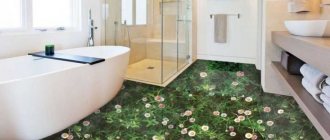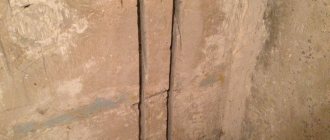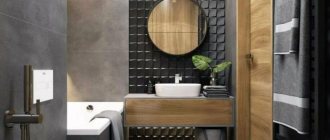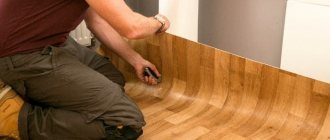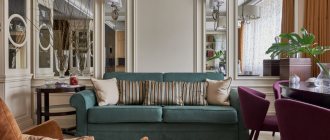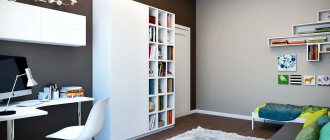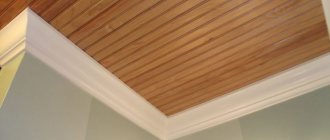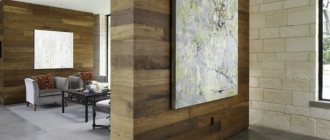Tile becomes the standard solution when planning to decorate the walls in the bathroom. However, the option is not the cheapest, and painting the surface can be an inexpensive alternative. In addition, painting the walls in the bathroom can be an excellent opportunity to create an original interior. Modern paints and varnishes allow you to obtain high-quality results, and you can apply a variety of base design options. But it is important to choose the right paint so that it can cope with the effects of moisture. The method will be described in detail below.
Benefits of coloring
Before you paint your bathroom walls instead of tiles, you need to evaluate the positive aspects of the finish. The following advantages of coloring can be noted:
- A budget option, when compared with the expenses that will follow when choosing a tile material, they are much higher when painting. The paint lasts less than the tiles, but even taking into account the need to re-paint the walls, the cost will still be lower;
- Ease of work. Laying slabs on the base is a labor-intensive process that requires certain skills. Painting the walls in the bathroom is difficult only at the preparation stage; it is necessary to create a smooth base without flaws so that a layer of paint does not highlight them;
- Unique design options. Paintwork materials have a large assortment of colors, and there are also many ideas for painting work. You can combine colors, create designs and much more, so getting a beautiful interior is not a difficult task;
- Easy to maintain and eliminate defects. The coating is easy to clean; high-quality compositions can maintain the brightness of the color for a long time and withstand negative factors. If scratches appear, they can be easily filled with putty and painted over again.
Paintwork materials have a large assortment of colors, and there are also many ideas for painting work.
Surface preparation
When starting to paint the bathroom, you need to carry out several preparatory measures. First, the old finish is removed from the surface. If the walls have been painted, a solvent will be needed to remove the paint layer. Ceramic tiles will have to be knocked down. Wallpaper in the bathroom can be removed using a knife or metal spatula, after wetting the surface with water.
If renovations are being carried out in a new apartment, the surface should be carefully plastered and leveled. Only in this case will the paint lie flat and have a neat appearance. Often, in the rough finish, plastering of walls with many flaws and irregularities is allowed. It is recommended to knock down such a coating and replace it with a new layer of plaster.
When the layer of plaster has hardened, you can move on to the next stage - leveling the surfaces with putty. For these purposes, it is best to use a special moisture-resistant and water-emulsion version of this material. It is also recommended to select substances that contain antiseptic and antifungal impurities.
Before painting, the walls also need to be treated with a waterproof primer.
What's the best way to paint bathroom walls?
Painting a bathroom can be done with different compositions. However, it is important that the paint is highly resistant to moisture in order to reliably protect the base and last longer. The following properties are also required:
- Antibacterial property;
- Vapor permeability;
- Harmless to humans;
- Abrasion resistance.
It is important that the paint is highly resistant to moisture in order to reliably protect the base and last longer.
Acrylic and latex
Acrylic is a good option for painting walls in a bathroom or bathroom. It is safe and suitable for interior work. Among the advantages are:
- Ease of application;
- Quick drying;
- Wear-resistant.
Acrylic is a good option for painting walls in a bathroom or bathroom.
The latex-based composition is distinguished by the creation of a film coating on the surface, which serves as a barrier against harmful factors, and dirt does not linger on it.
The latex-based composition is distinguished by the creation of a film coating on the surface, which serves as a barrier against harmful factors.
Oil paint
Oil paints are considered an outdated type of material, but have retained a number of advantages. They note the durability of the coating, high level of adhesion, and good hiding power. The layer can be washed, but without using household chemicals.
But they smell too strong, and they are toxic in liquid form.
They note the durability of the coating, high level of adhesion, and good hiding power.
Water-based paint
The water-based composition is distinguished by an aqueous base, so water is also used for dilution. Until the layer has dried, it can be easily removed with water, but after that a reliable coating is created. Among the advantages are the following:
- Doesn't peel off;
- Allows the walls to “breathe”;
- Withstands exposure to ultraviolet radiation;
- Wide color range.
The downside is the inadmissibility of frequent washing, which leads to abrasion of the layer.
The water-based composition is distinguished by an aqueous base, so water is also used for dilution.
Chlorinated rubber
This type is widely used for treating the surfaces of boats and yachts. For this reason, it is clear that they are considered waterproof. However, their use is limited to a temperature value of +27 degrees, which makes it difficult to apply for a bathroom for painting, where the indicators may be higher.
This type is widely used for treating the surfaces of boats and yachts.
Glossy or matte - which is better?
How to paint the walls in the bathroom with a glossy or matte product is an important issue that needs to be resolved. Bathroom paints are available in glossy, semi-gloss and matte. The resulting appearance depends on the choice of effect. The gloss reflects light well, the space visually expands.
Using it on the ceiling will help create a brighter and larger space. Removing dirt from a smooth surface is easy. But this option highlights any flaws in the base, so you will have to carefully level the walls before painting.
The gloss reflects light well, the space visually expands.
Matte can cover up some minor defects; when applied, one layer may be enough to cover the base well. The downside is more complex care. Semi-gloss finishes are less reflective than gloss finishes.
Matte can cover up some minor defects; when applied, one layer may be enough to cover the base well.
Textured paints
Such coloring agents are distinguished by the creation of an unusual relief coating, which can be of different types, this is influenced by the selected type of paint and application tool. A thick coating is made, so the composition consumption is higher than regular paint.
Water is used for dilution, but the composition must not be diluted to a too liquid state, otherwise the textured effect will be lost. The layer can cover small defects in the base. Withstands ultraviolet radiation, durable, moisture resistant.
But to get a decent result, some skills are required, so it is advisable to practice in advance.
Such coloring agents are distinguished by the creation of an unusual relief coating, which can be of different types.
How to paint it yourself?
Before starting work, you need to prepare the necessary tools and materials:
- dye;
- putty;
- primer;
- sandpaper;
- film to protect plumbing fixtures and floors;
- paper tape;
- protective equipment (respirator, safety glasses and gloves);
- pallet;
- rollers of different sizes;
- brush.
If everything you need is available, you can start painting the walls.
How to properly prepare the walls?
The paint will adhere well only to an ideally prepared surface, so minor repairs are indispensable.
- Remove the old covering. If it's tile, knock it down and remove any remaining mortar.
- Wash the walls to remove dust.
- If the surface has significant differences and unevenness, then everything will have to be leveled with plaster.
- If there are small defects on the wall, putty them first. Let it dry and only then treat the entire wall. It is important to choose a moisture-resistant putty (for example, latex-based).
- Once completely dry, go over it with sandpaper to remove any rough edges.
- Remove any remaining material and dust particles from the surface using a damp cloth and broom.
- Carefully prime the walls with a waterproofing compound in accordance with the instructions. A new layer cannot be applied until the previous one has completely dried.
The photo shows the dismantling of old tiles
Step-by-step instruction
The surface is prepared, painting can begin.
Advice! It is better to pour all the paint you are going to use into a large container and mix. Paint of the same color from different cans may differ in nuances. By mixing them together, you will get a uniform shade.
- Measure the area of the bathroom walls. Calculate how much paint you need based on the information on the label, add 10-15% of the amount received in reserve.
- Remove covers from outlets and switches and cover them with masking tape. Don't forget to turn off the power before doing this.
- Also seal the boundaries of the walls with the floor and ceiling with tape. Place a film on the floor to protect the floor.
- Stir the paint so that there are no lumps left. If you added color, make sure there are no streaks.
- Pour it into the tray.
- Use a brush to paint corners and hard-to-reach places.
- Dip the roller into the tray and roll it several times to ensure the paint is evenly distributed without gaps.
- Start painting from the corner so that each strip overlaps the previous one by 2-3 cm.
- Proceed with applying the second layer only after the first has completely dried.
- Remove the tape before the paint dries, otherwise it will come off with it.
Video
Color spectrum
When painting a bathtub, design plays an important role; you need to choose the optimal shade so that it matches the rest of the decor in the room. Often the room is small in size; to visually enlarge the space, light colors are chosen.
The choice of color is made mainly taking into account the preferences of the owners. If a monochrome combination is used, then the color of the walls should match the pastel colors of the wooden furniture. If you want to create a brighter interior, use different colors, from three, but no more than six.
When painting a bathtub, design plays an important role; you need to choose the optimal shade so that it matches the rest of the decor in the room.
What paint to choose for the bathroom
A bathtub to be painted at home should be coated with high-quality compounds. It is necessary for the product to last longer without losing its decorative and protective properties. Therefore, when choosing, it is important to study the technical characteristics of the composition.
It is necessary for the product to last longer without losing its decorative and protective properties.
Which ones can be used without odor?
When working in a Khrushchev or other building, it is important that residents do not suffer from a pungent odor when work is being done. Products that do not emit an unpleasant odor are water-dispersed and water-based.
Alkyd and oil types have a strong smell during drying; if the renovation is being carried out in a room where people do not yet live, then their use is possible.
Products that do not emit an unpleasant odor are water-dispersed and water-based.
Which ones won't last long?
When painting is done over the entire wall, erased layers will appear over time in areas immediately close to the water. Therefore, a combination of tiles and paint in the bathroom will be the best choice; the tile material is laid in problem areas, and the walls are painted in the rest. This combination option will help extend the finishing period.
A combination of tiles and paint in the bathroom will be the best choice.
Paints that are not recommended for painting in the bathroom
Compositions not intended for interior use should not be used in the bathroom; they are harmful to human health. It is not advisable to use species that are not water-resistant and do not allow air to pass through, which will lead to the formation of mold and mildew.
Compositions not intended for interior use should not be used in the bathroom; they are harmful to human health.
Waterproof
The following types are considered waterproof paints: acrylic, enamel, silicone, latex, alkyd. The degree of resistance depends on the manufacturer and is written on the packaging.
The degree of resistance depends on the manufacturer and is written on the packaging.
How to buy quality paint
To choose high-quality paint from the variety of options on the market, it is advisable to study reviews on the Internet in advance. You should not purchase an option that is too cheap; it is unlikely to give good results. Be sure to read the description, which usually states the possibility of use in bathrooms.
Be sure to read the description, which usually states the possibility of use in bathrooms.
The area under the ceiling has been painted
For some, this technique resembles the “Soviet” version of bathroom cladding, but it still does not lose its relevance. The implementation of the idea is found in both expensive classical style and luxurious art deco.
Looks great with high ceilings and allows you to save on the amount of tiles. It is also appropriate for low ceilings, when there is about 40 cm of free space on top - the painted area looks like a frame and is complemented by moldings.
What is better to paint
You can apply paint with a spray gun, brushes and roller. The first tool will give quick and high-quality results, but it is expensive and also requires certain operating skills.
Brushes are used only for hard-to-reach areas; it will be difficult to cover all the walls with them, and the process will be delayed. Rollers allow you to more quickly and evenly apply the composition to the walls.
You can apply paint with a spray gun, brushes and roller.
Consumption of paint and additional materials
The average consumption of any material is indicated on the packaging. To calculate how much product to purchase, you need to know the area and number of layers that will be made. Consumption may increase if minor defects need to be covered.
The level of hiding power of the paint also affects the consumption.
To calculate how much product to purchase, you need to know the area and number of layers that will be made.
Preparatory work
Surface preparation consists of obtaining a leveled base. Depending on the preparedness of the walls, you will need to plaster or putty the surface. Plaster is used when the differences are large.
Paint highlights any imperfections, so you need to level the walls well and create a smooth base.
Surface preparation consists of obtaining a leveled base.
Dismantling the old coating
Before painting, the bathroom must be completely cleared of previous finishing material. How to remove the old coating is decided taking into account its type. After work, you will need to remove all remaining contaminants and degrease the base.
Before painting, the bathroom must be completely cleared of previous finishing material.
Applying putty
Applying the putty solution yourself must be done using a suitable composition. For a bathroom, the use of a mixture with the following properties is required: resistant to moisture, temperature changes and high temperatures.
These include moisture-resistant cement and polymer water-resistant types.
For a bathroom, the use of a mixture with the following properties is required: resistant to moisture, temperature changes and high temperatures.
Base primer
Priming is an essential step; it helps improve moisture protection and increase adhesion. Only the primer option with deep penetration and moisture resistant is selected. For application, use a roller with fine bristles.
Priming is an essential step; it helps improve moisture protection and increase adhesion.
Painting the bathroom
Once the bathroom painting design is determined, the painting technology becomes clearer. The lesson of a single-color coating is easier than applying different colors; the following steps are performed:
- The paint mixes well.
- If necessary, color is introduced.
- First, paint the joints in the corners and hard-to-reach areas using a narrow brush.
- Afterwards, the main areas are painted with a roller or wide brush.
- When the first layer dries well, apply the second. The number of layers is determined based on the obtained quality of wall painting.
When the first layer dries well, apply the second.
Half of the bathroom painted
This traditional technique involves dividing the wall into two sections. With this approach, the decor looks strict and laconic, so it allows you to play with the decor. The proportions can be varied by painting a smaller or larger part of the walls.
If laid evenly, the joint need not be processed. An option is available with a frame in the form of narrow tiles or mosaics, as well as a ceramic shaped edge, appropriate in a classic style.
Decorative painting methods
Creating drawings with your own hands is not accessible to many; a complex process can be replaced by using stencils, or using other decorative methods for obtaining an original design.
Creating drawings with your own hands is not accessible to many; a complex process can be replaced by using stencils.
Using stencils
A stencil is a convenient option to create beautiful patterns on the wall. They come on a self-adhesive base; if there is none, then a stencil is attached to the surface painted in the main tone using masking tape. The shade chosen for the drawing is rolled with a roller; it is important to paint the areas well in order to get a clear image.
It is important to paint the areas well to get a clear image.
Striped walls
Creating stripes on the surface helps to increase space and create an unusual design in the room. What width and color to choose depends on the wishes of the master; there are no restrictions in this regard. The boundaries of the strip are marked with masking tape to make straight lines.
Creating stripes on the surface helps to increase space and create an unusual design in the room.
Rollers for applications
This tool allows you to quickly apply a pattern to a surface. After the base layer has dried, work begins with an appliqué roller. It is necessary to move the tool evenly so that the pattern is applied evenly; the second strip of patterns should fit snugly against the first.
It is necessary to guide the tool evenly so that the pattern is applied evenly.
Common mistakes when painting walls
To apply paint beautifully on the base yourself, you need to know not only the technology of work, but also the common mistakes of inexperienced craftsmen:
- Painting walls without prior preparation;
- Skip priming the base;
- Using excessively thick or thin paint;
- Chaotic coloring of the base; tools should always be moved strictly in one direction so as not to leave marks;
- Failure to comply with drying times for layers.
To apply paint beautifully on the base yourself, you need to know not only the technology of work, but also the common mistakes of inexperienced craftsmen.
Painting your bathroom walls can be an opportunity to renovate inexpensively while still achieving stylish results. To do this, the choice of design should be approached with special attention, because there are many painting options.
Pros and cons of painted walls
Finishing a bathroom by painting has its own specific advantages and disadvantages.
Advantages:
- The material is cheap and accessible. When treating a bathroom with tiles and painting, the last method will be cheaper and more convenient.
- Simplicity and ease of use, ease of care. The coating is fairly uniform and easy to care for by periodically wiping the surface with a damp cloth or brush. It is not subject to significant contamination and is easy to wipe off.
- The finishing method by painting provides sufficient scope for the implementation of all kinds of design ideas. If you have a certain talent, you can paint full-fledged paintings and panels in the room, using various shades of the entire color palette, applying ornaments, patterns and thematic designs.
- The possibility of using specific and original decorative methods of painting, combining with other types of finishing: tiles, ceramic tiles, with elements and structures made of plastic, with other metal and ceramic materials.
Flaws:
- Less durability compared to tiles.
- Places constantly exposed to water: shower stalls, places near the sink, are not recommended to be painted.
- A painted surface is more susceptible to mechanical stress.
